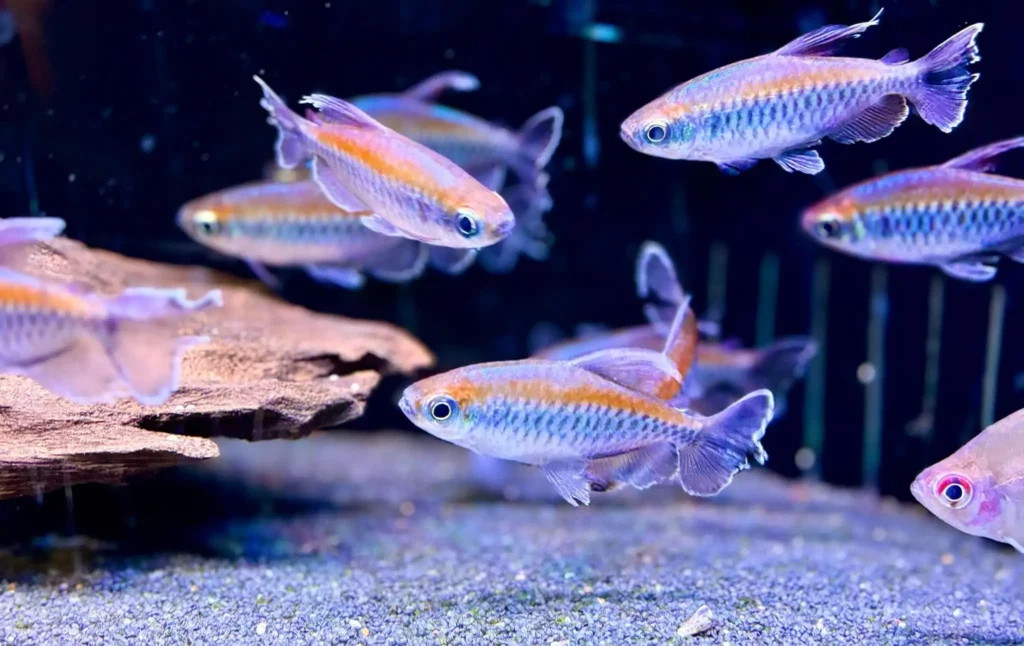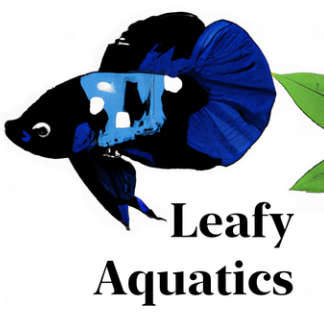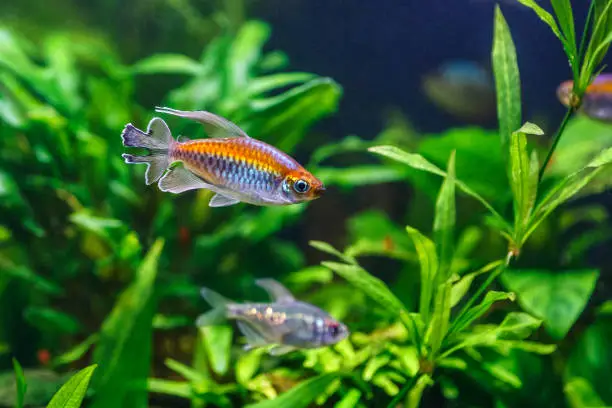Congo Tetra (Phenacogrammus interruptus)
The Congo tetra are incredibly interesting freshwater aquarium fish, beloved for their vibrant colors, iridescent fins, and peaceful schooling behavior. These are a great fish for beginners to intermediate aquarists, as Congo tetra care is known to be easy to moderate due to their active nature and need for ample swimming space. It’s important to only introduce Congo tetras into an aquarium that is well established and has stable water parameters to prevent stress.
Congo tetras are also sometimes referred to as African tetras or jewel tetras. They’re omnivores and feed primarily on small insects, crustaceans, and plant matter in the wild, however in a tank environment you’ll want to provide a varied diet to ensure they’re getting proper nutrition.
They are native to the Congo River basin in Central Africa, particularly in the Democratic Republic of the Congo. In the wild, Congo tetras can be found in areas with moderate currents, dense vegetation along the edges, and open swimming areas. It serves them well to be provided the same environment in an aquarium setting. In general, I’d recommend a densely planted tank with plenty of open space for swimming, some driftwood, and subdued lighting to mimic their natural habitat.
Congo Tetra Species Overview
Adult Size: 3-3.5 inches
Lifespan: 3-5 years
Diet: Omnivore
Care Level: Easy-Moderate
Minimum Tank Size: 30 gallons
Temperature: 72-82°F (22-28°C)
pH: 6.0-7.5
Origin: Central Africa (Congo Basin)
Congo Tetra Care
Congo tetra care requirements are not overly demanding, however you’ll want to ensure that you provide them with the proper environment in which they will thrive. They’re highly social and do best in schools of at least 6-8 individuals, the larger the better. However, it’s important not to overstock your Congo tetra tank, as they need plenty of space to swim and display their natural behaviors.
In general, you’ll find Congo tetras actively swimming in the mid to upper levels of the aquarium, often schooling together in open areas. They’re usually foraging for food particles, and bright colors with active fin displays are a good sign that they’re healthy and comfortable.
Feeding
Congo tetras are omnivores, feeding on small invertebrates, insects, and plant matter in the wild. In an aquarium, it’s essential to provide them with a balanced diet to ensure their health and well-being, vibrant colors, and active behavior. For obvious reasons, a well-established aquarium with some natural algae and detritus will promote their longevity and lead to a more balanced diet.
They readily accept high-quality flake foods, pellets, and granules as staples. Supplement with frozen or live foods such as bloodworms, brine shrimp, daphnia, or mosquito larvae for variety. Occasionally they may be fed blanched vegetables such as zucchini or spinach. Be sure to monitor their feedings closely as Congo tetras can be enthusiastic eaters, but overfeeding can lead to water quality issues and health problems like bloating.

Water Conditions
Congo tetras thrive in freshwater aquariums with water conditions that mimic their natural habitat. You’ll want to have a quality filter system, as Congo tetras hail from moderately flowing, well-oxygenated river waters. Congo tetra care can be straightforward, but if you can keep adequate water parameters you’ll have a much easier time keeping these fish.
Congo tetras prefer slightly acidic to neutral water, with a pH range of around 6.0-7.5, however sudden fluctuations in pH should be avoided. Additionally, they do best in soft to moderately hard water, with a hardness level (GH) between 5-15 dGH.
They are also sensitive to high levels of ammonia, nitrites, and nitrates, so care should be taken to maintain pristine water quality through regular changes. Additionally, Congo tetras are sensitive to fluctuations in water parameters, so it’s essential to acclimate them slowly to any changes in their environment and when adding them to a new tank.
Congo Tetra Breeding
Breeding Congo tetras in captivity can be challenging, and successful breeding often requires specific conditions and careful attention to detail. First of all, determining the sex of Congo tetras is relatively easy: mature males are larger, more colorful, with extended dorsal and anal fins, while females are smaller, rounder, and less vibrant.
To encourage breeding, provide a well-established aquarium with plenty of hiding spots, fine-leaved plants, and spawning mops or java moss. Ensure that water quality is excellent, with stable parameters. When conditions are right, male Congo tetras will display vibrant colors and chase females, leading to spawning. The female will scatter adhesive eggs among plants or substrate.
Hatching and Fry Care
After spawning, it’s crucial to provide proper care for the eggs. The eggs are sensitive to light and fungal infections, so the breeding tank should be kept dimly lit, and consider adding methylene blue as a fungicide. It’s also essential to maintain excellent water quality and provide gentle aeration to ensure oxygenation.
The eggs will hatch in about 5-6 days, and the fry will consume their yolk sacs before becoming free-swimming. Offer them small, live foods such as infusoria, microworms, or finely powdered commercial fry food. Fry are delicate and require pristine water conditions. Regular water changes and careful feeding are essential for their growth and development.
Common Congo Tetra Diseases and Health Issues
Congo tetras are relatively hardy fish, but it is common for them to experience certain health issues in an aquarium environment if water quality declines. Look to monitor their activity and colors closely, as fading colors or lethargy can be a root cause of other health issues.
Some additional Congo tetra health issues to look out for include high stress levels, parasites like ich, and bacterial or fungal infections such as fin rot. Stress can weaken their immune systems, making them more susceptible to diseases. Factors such as poor water quality, overcrowding, or aggressive tankmates are the typical causes of Congo tetra stress. Quarantining new fish and maintaining good hygiene can help prevent parasite outbreaks, while maintaining proper water parameters and preventing injuries will reduce the chance of infections.
Congo tetras can be treated with appropriate medications, but it’s important to use them judiciously and under the guidance of a veterinarian or experienced fish keeper. Medications should only be used to treat specific issues and should not be used as a preventive measure or without a proper diagnosis, as these fish can be sensitive to certain chemicals.
Congo Tetra Tank Setup
As mentioned above, Congo tetras will thrive in an aquarium that is densely planted along the edges and gives them plenty of open space to swim. The best aquarium setup for Congo tetras mimics their natural habitat. Many aquarists choose to utilize subdued lighting, or to integrate driftwood and Indian almond leaves into their Congo tetra aquascape. This will help to leach tannins into the water and darken the tank, which is similar to their natural environment.
I’d recommend at least a 30-gallon aquarium for a small school of Congo tetras, however a 40-gallon or larger is better especially if you’re looking to have a community tank. It’s important to reiterate, for best results keeping Congo tetras they should only be added to a well-established aquarium that is fully cycled and has been running for a few months.
Tankmates
Congo tetras are peaceful and do well with other small, non-aggressive fish that share similar water parameter requirements. When selecting tankmates for Congo tetras, it’s best to choose fish that come from similar natural habitats or compatible community species. Here are some good tankmates that coexist well with Congo tetras:
- Corydoras catfish, including panda corydoras
- Other tetras, such as lemon tetras or black skirt tetras
- Rasboras, including harlequin rasboras
- Rainbowfish or peaceful barbs
Be sure not to overstock your aquarium. My recommendation would be to check out an aquarium stocking calculator such as aqadvisor.com to help gauge the stocking level of your tank.
Look to avoid keeping Congo tetras with large or aggressive fish that may intimidate or harm them, such as cichlids or fin-nippers. Additionally, always monitor the behavior of tankmates to ensure they are compatible and not causing stress to the tetras.
Congo Tetra Care Summary
Congo tetras are fascinating and beneficial additions to a freshwater aquarium, known for their stunning colors and lively schooling behavior. While Congo tetra care requires some special considerations, such as a spacious tank with open swimming areas and a varied diet, they can thrive in the right environment. By providing them with the proper care, water conditions, and tank setup, you can enjoy the company of these charming fish and keep them healthy for years to come.

